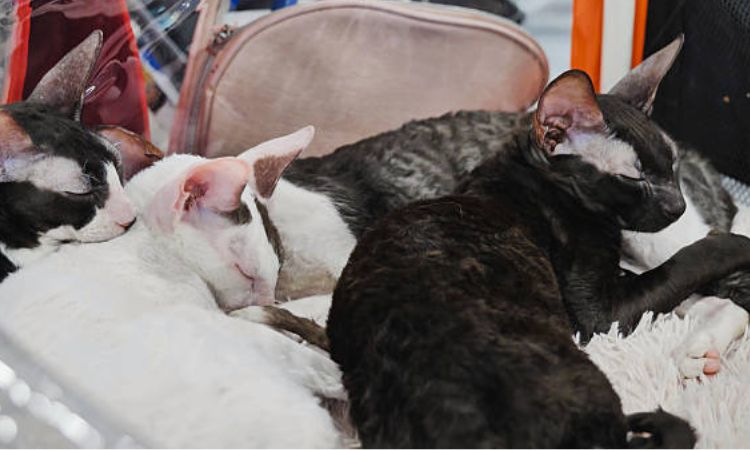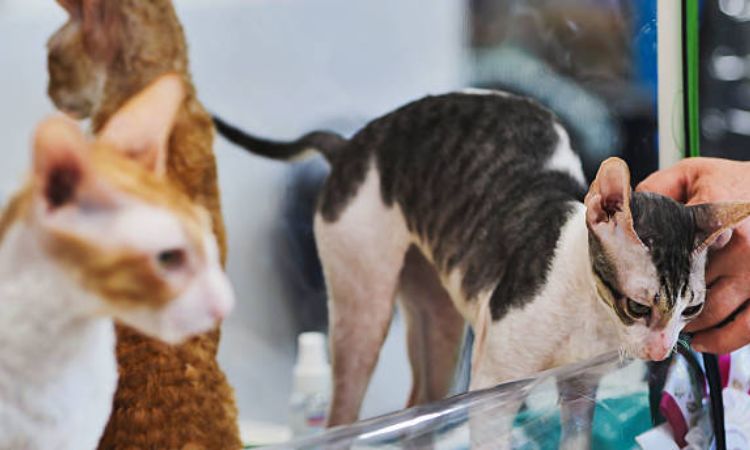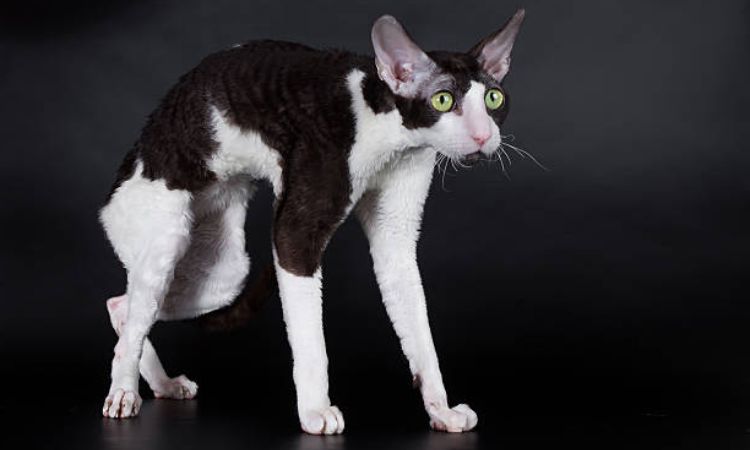The Cornish Rex is a charming and playful breed with a personality as distinctive as its curly coat. But like all breeds, they come with their own set of health quirks that every owner should be aware of.
Whether you’re a first-time Cornish Rex parent or a seasoned pro, knowing the potential health issues that could affect your furry friend is essential for ensuring a long, happy life together. In this guide we’ll walk you through seven critical health concerns that all Cornish Rex owners should keep an eye on.
1. Hypertrophic Cardiomyopathy (HCM)
Hypertrophic cardiomyopathy (HCM) is a common and serious heart condition that affects many cat breeds, including the Cornish Rex. It involves the thickening of the heart muscle, which hinders the heart’s ability to pump blood efficiently. This leads to an increased risk of blood clots and sudden cardiac events.
- Symptoms: Early-stage HCM is often asymptomatic, making it difficult to detect without veterinary tests. As the disease advances, signs can include lethargy, shallow or rapid breathing, poor appetite, and unexplained weight loss. In severe cases, blood clots can form, potentially leading to sudden hind limb paralysis or even a stroke.
- Management: Although HCM is a progressive condition with no cure, the disease can be managed to improve the cat’s quality of life. Medications like beta-blockers or calcium channel blockers may be prescribed to help control heart function and prevent complications such as clot formation. Regular vet check-ups and monitoring of the cat’s heart health are essential.

2. Patellar Luxation
Patellar luxation is a joint disorder in which the patella (kneecap) slips out of its normal position, causing pain and difficulty in movement. Cornish Rex cats are particularly prone to this condition, especially if they lead a very active lifestyle or have genetic predispositions.
- Symptoms: Affected cats may exhibit lameness or a “hopping” motion, often shifting from leg to leg as the kneecap moves out of place. They may also show a reluctance to jump, climb, or run, and may express discomfort or pain when the leg is touched.
- Management: The severity of patellar luxation determines the treatment plan. Mild cases may be managed with joint supplements, anti-inflammatory medications, and weight management to reduce stress on the joints. For more severe cases, surgical correction may be required to realign the kneecap and prevent further damage.
3. Polycystic Kidney Disease (PKD)
Polycystic kidney disease (PKD) is a hereditary condition that causes fluid-filled cysts to form in the kidneys. While it is more common in breeds such as Persian cats, Cornish Rex cats are also susceptible. Over time, the cysts grow larger and interfere with kidney function, which can lead to kidney failure.
- Symptoms: PKD often develops slowly and may not show obvious signs until the kidneys are significantly damaged. Initial signs include increased thirst and urination, loss of appetite, weight loss, lethargy, and vomiting. In some cases, affected cats may develop high blood pressure as well.
- Management: There is currently no cure for PKD, but its progression can be slowed with proper care. Early diagnosis through regular veterinary check-ups is crucial. Cats with PKD may benefit from a special kidney-friendly diet, fluid therapy to prevent dehydration, and medications to manage blood pressure or other related symptoms. Keeping your cat hydrated and monitoring their kidney health regularly is essential to slowing the disease’s progression.
4. Progressive Retinal Atrophy (PRA)
Progressive retinal atrophy (PRA) is a genetic condition that affects the eyes, leading to a slow, progressive degeneration of the retina, eventually causing blindness in affected cats. While PRA does not cause pain, it significantly impacts a cat’s ability to see.
- Symptoms: Initially, cats with PRA may have difficulty seeing in dim lighting or may appear to be bumping into furniture or walls. You might notice dilated pupils that don’t respond to changes in light. As the disease progresses, the cat may become more withdrawn or cautious in new environments, relying heavily on memory and scent.
- Management: Unfortunately, there is no treatment or cure for PRA. However, since the condition is not painful, cats can often adapt well to losing their vision. With the right environment, they can live happily without sight. Owners can help by keeping their home layout consistent, avoiding rearranging furniture, and providing extra care in high-traffic areas to prevent accidents. Consulting with a veterinarian about modifying their living space for ease and safety is highly recommended.

5. Dental Disease
Dental health is an important aspect of overall well-being for Cornish Rex cats. Like many breeds, they are prone to dental issues due to their unique mouth structure. Crowded teeth can result in a greater accumulation of plaque and tartar, which, if left unchecked, can lead to gum disease, tooth decay, and more severe oral health issues.
- Symptoms: Bad breath (halitosis) is one of the earliest signs of dental problems. As the condition worsens, cats may experience difficulty eating, especially with dry food or hard treats. Swollen, inflamed, or bleeding gums and pawing at the mouth are also signs of advanced gum disease.
- Management: Regular dental care is crucial for preventing dental disease in Cornish Rex cats. Brushing your cat’s teeth with a pet-safe toothbrush and toothpaste is the most effective way to manage plaque and prevent tartar buildup. Additionally, offering dental treats or toys designed to clean teeth can complement daily brushing. Regular veterinary checkups and professional cleanings, typically once a year, are also recommended to ensure the cat’s dental health is maintained.
6. Hypotrichosis
Hypotrichosis is a genetic disorder that results in abnormal hair growth, leading to either thinning or complete hair loss in certain areas of the body. While Cornish Rex cats naturally have a short and sparse coat, hypotrichosis is a more severe form of hair loss that makes the skin more exposed and vulnerable to the elements.
- Symptoms: Affected cats will show noticeable bald patches or areas with very thin hair. The skin may appear red or irritated, particularly where the hair loss is most pronounced. In some cases, the lack of a protective coat can leave the skin vulnerable to sunburn, infections, and environmental irritants.
- Management: Treatment for hypotrichosis mainly focuses on managing the skin’s health. Regular bathing with mild, hypoallergenic pet shampoos can help soothe and protect the skin. Additionally, using pet-safe sunscreen on exposed skin areas (such as the ears, nose, and belly) when outdoors can prevent sunburn. Keeping the cat indoors or in shaded areas during peak sun hours is also important to avoid prolonged exposure to UV rays. Regular skin check-ups with the vet can help monitor and treat any secondary infections or irritations that arise.

7. Skin Sensitivities and Sunburn
Due to the Cornish Rex’s unique coat, which lacks a dense top layer, their skin is more exposed to external factors, making them prone to skin sensitivities, allergies, and sunburn. This breed’s thin, curly coat offers little protection from the sun, and they can easily develop painful burns if not properly cared for.
- Symptoms: Symptoms of skin sensitivities include redness, itching, and the appearance of scaly patches or hot spots. If left untreated, these can develop into sores or infections. Sunburn, on the other hand, usually manifests as red, tender skin, especially on areas with minimal hair coverage like the ears, nose, and belly. In severe cases, sunburn can lead to peeling or blistering.
- Management: Preventing sunburn and skin irritation is key to maintaining the Cornish Rex’s skin health. Keeping your cat indoors during peak sunlight hours (10 AM – 4 PM) can help limit sun exposure. If your cat enjoys outdoor time, applying a vet-recommended sunscreen to exposed skin areas can provide protection. Regular grooming and checking for any signs of skin infection or irritation are also essential. If allergies are suspected, work with your vet to identify potential triggers and explore treatment options like antihistamines or special shampoos to soothe the skin.
Being aware of these seven health concerns can make a significant difference in your Cornish Rex’s well-being. With attentive care, regular veterinary checkups, and a supportive environment, you can help your cat live a vibrant, active, and comfortable life. Understanding these risks allows you to respond early, manage conditions effectively, and ensure that your Cornish Rex thrives for many years.






